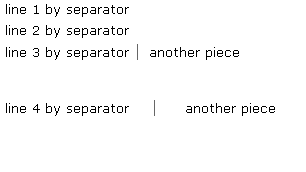Separator"
From Documentation
Tmillsclare (talk | contribs) |
|||
| Line 7: | Line 7: | ||
= Employment/Purpose = | = Employment/Purpose = | ||
| − | + | A separator is used to insert a space between two components. There are several ways to customize the separator. | |
| − | + | * By use of the orient attribute, you are able to specify whether the separator is vertical or horizontal. By default it is a horizontal separator, which inserts a line break. On the other hand, a vertical separator inserts white space. | |
| + | * By use of the bar attribute, you can control whether to show a horizontal or vertical line between components. | ||
| + | * By use of the spacing attribute, you can control the size of spacing. | ||
= Example = | = Example = | ||
Revision as of 00:10, 27 May 2010
Separator
Employment/Purpose
A separator is used to insert a space between two components. There are several ways to customize the separator.
- By use of the orient attribute, you are able to specify whether the separator is vertical or horizontal. By default it is a horizontal separator, which inserts a line break. On the other hand, a vertical separator inserts white space.
- By use of the bar attribute, you can control whether to show a horizontal or vertical line between components.
- By use of the spacing attribute, you can control the size of spacing.
Example
line 1 by separator
<separator />
line 2 by separator
<separator />
line 3 by separator
<space bar="true" />
another piece
<separator spacing="20px" />
line 4 by separator
<space bar="true" spacing="20px" />
another piece
Supported events
| None | None |
Supported Children
*NONE
Use cases
| Version | Description | Example Location |
|---|---|---|
Version History
| Version | Date | Content |
|---|---|---|
